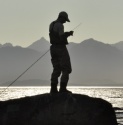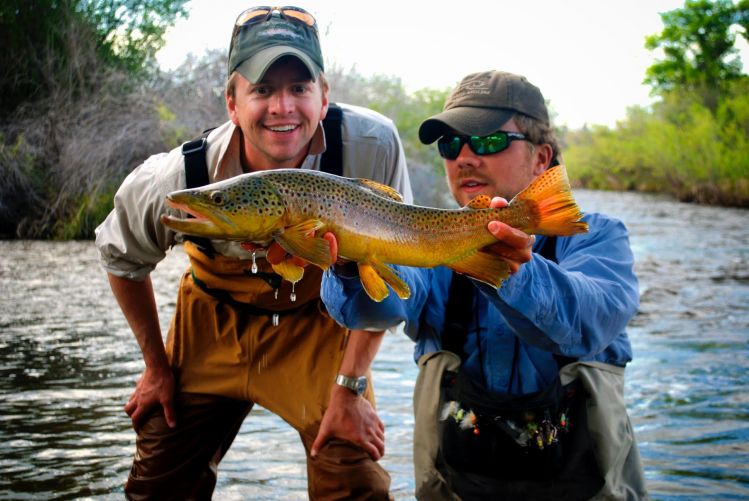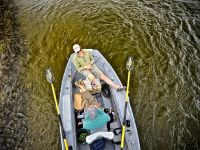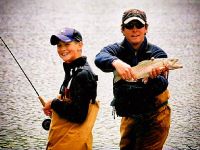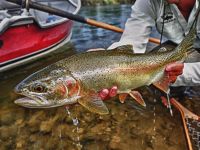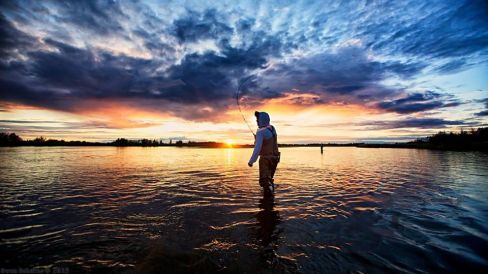Fd: First, why do you think every fly fisherman should visit Wyoming at least once?
Lack of other people. Wyoming is the least populated state in the Union and there seems to be a direct correlation between the quality of a fishery and that fishery’s proximity to a population center.
Fd: During which months is the season open over there?
Trout season is year-round in Wyoming. Most all of the winter opportunities take place on tail-water rivers that have sections below dams that remain un-frozen. There are also a fair number of spring creeks that remain open throughout the winter. The bulk of our guide-season is from April 15th through November 15th with the best months being June, July, August and September.
Fd: What kind of fly fishing techniques are the most usual?
During our summer season it’s typical to default to fishing dry flies with floating lines. If the fish aren’t looking up we’ll simply add a dropper (a bead-head “whatever” usually will suffice). In our shoulder seasons (spring and autumn) we do have some fairly good streamer fishing options - particularly on bigger rivers with moderate to heavy sinking tips/lines.
Fd: What kind of fly-fishing gear should anglers take for a week over there?
Wyoming offers a large variety of options from small freestones and spring creeks to larger tailwater and medium to large rivers. Our region (the Bighorn Mountains) would be best covered with a shorter 4 weight (~ 8’) a 9’ #5 and a 9’ #6. All with floating lines.
Fd: What are the top 5 flies that should be included in our boxes?
Freestone:
Foam Hopper
Orange Stimulator
Parachute Adams
Prince Nymph
Black Woolly Bugger
Tail-waters:
Foam Hopper
Parachute Adams
Olive Beatis (dry)
Scud/sow-bug
Zebra Midge
Fd: How's the programme for a typical fly-fishing day?
Our outfit offers a lot of variety and in doing so, we do spend a fair bit of time behind the windshield to get to our destinations. Due to some of our water not being “directly under our noses”, our typical day is often an out early, back late, program. However, we do have plenty of world-class options only a few minutes away. Furthermore, we pride ourselves in our customizability. We want to be certain that we are accommodating everyone and their individual expectations accordingly.
Fd: How is the lodging in terms of accommodation and facilities?
Our guests stay at a variety of lodging providers including hotels and motels in our area. However, our featured and highly recommended lodging provider is the HF Bar Guest Ranch (www.hfbar.com). The second oldest guest ranch in the United States (likely the world) and a location that time seems to have overlooked. No phones, no televisions, no locks on the doors. There are thirty-three individual cabins, some that sleep up to sixteen people, and some that only can house a couple, all situated on the banks of the North Fork of Rock Creek where the “burble of the brook” lulls everyone to sleep at night. Each cabin has it’s own “old-school” ice box with ice delivered daily by a horse-drawn cart. Family style meals prepared by a professional chef, on site non-guided fly-fishing opportunities and a rustic charm that is distinctly American “West”.
Fd: How long before should anglers contact the lodge for reservations?
Two reservations must be made in advance. One to secure guides with Rock Creek Anglers and another to secure lodging at the historic HF Bar Ranch. Both entities will fully-book about a month or six weeks out.
Fd: Any other advice for those visiting your area?
Rock Creek Anglers offers rental equipment at a reasonable rate for those who may not want to travel with their own gear.
Also, there are plenty of opportunities for non-anglers including horse back riding, hiking, biking, historical tours of the General Custer Battlefield at the Little Bighorn and shopping in historic downtown Sheridan and more.
Visit and contact Rock Creek Anglers on our Travel Directory, right here: Travel.

